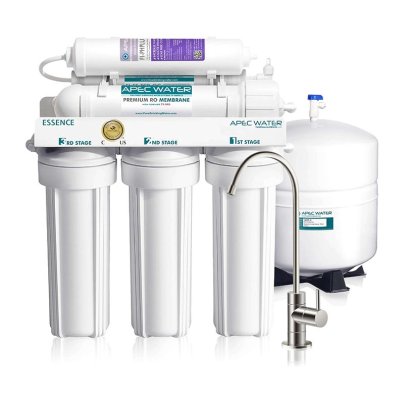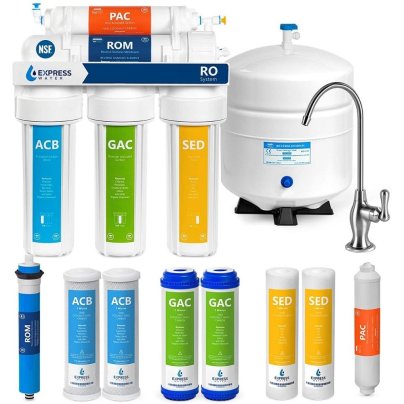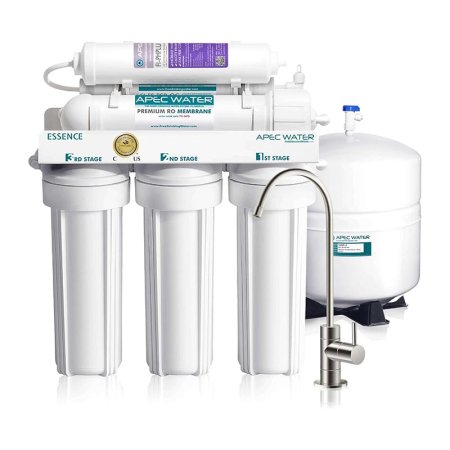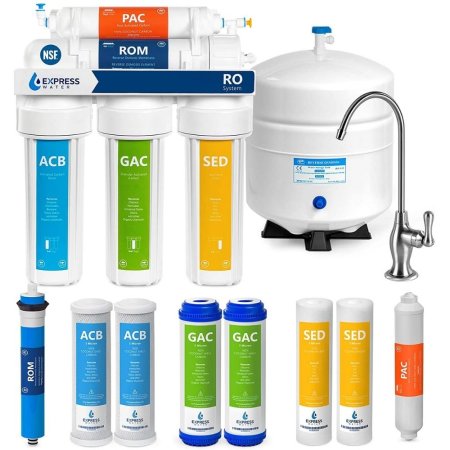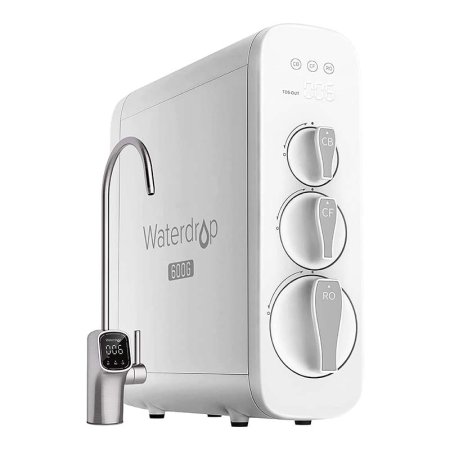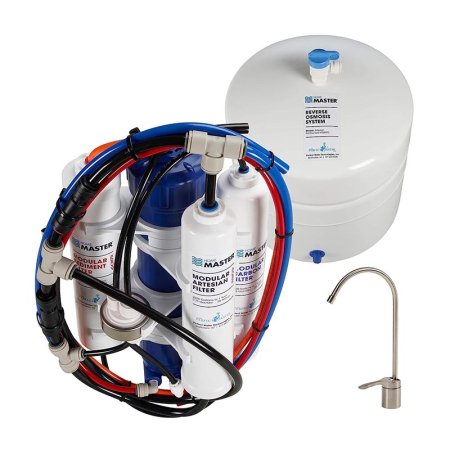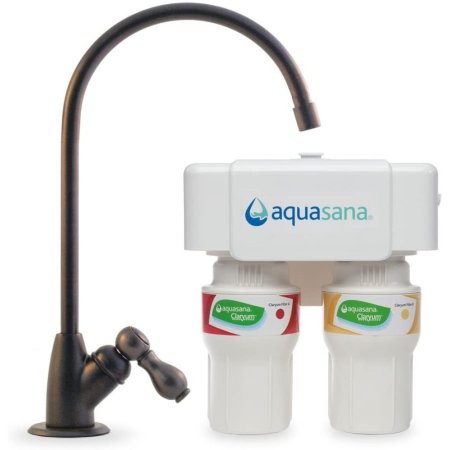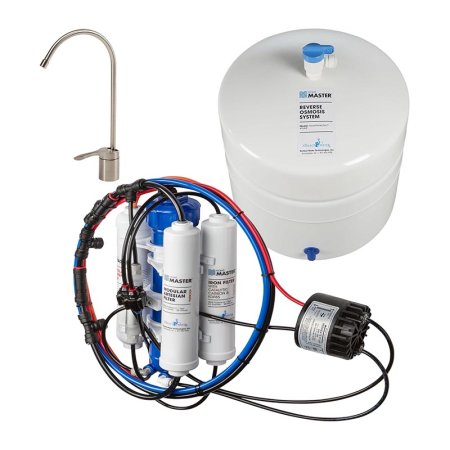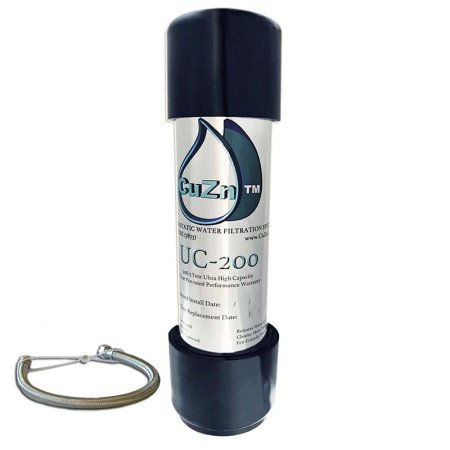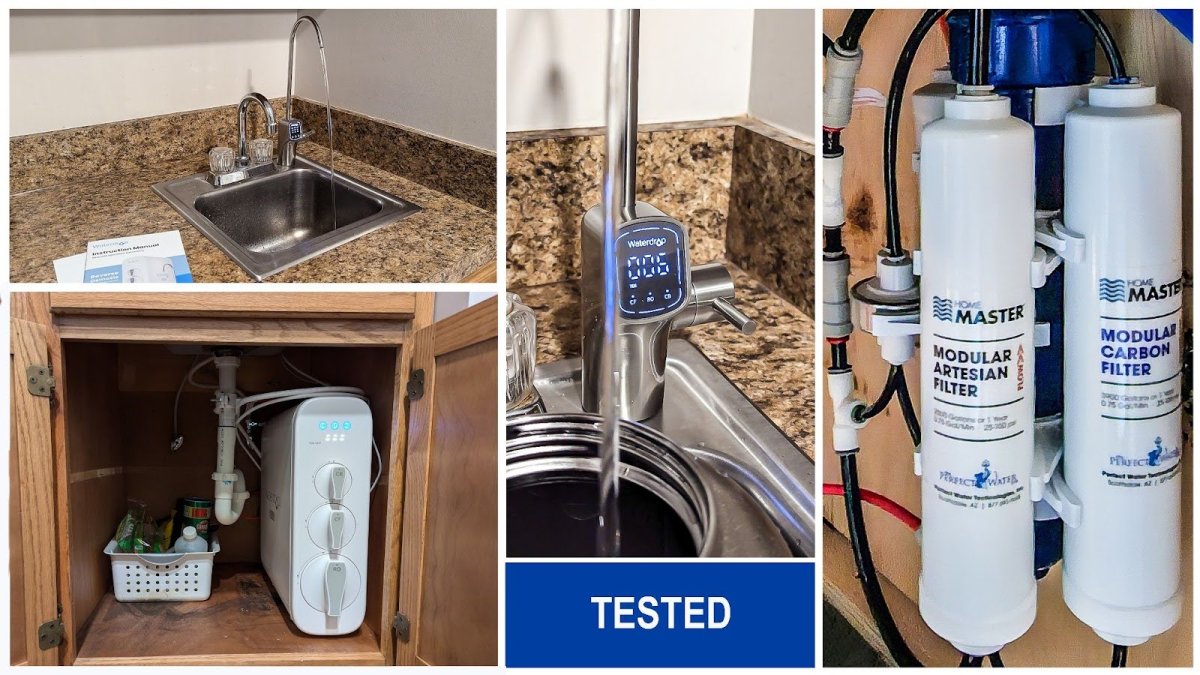
We may earn revenue from the products available on this page and participate in affiliate programs. Learn More ›
Remembering to refill 5-gallon carboys or buy cases of bottled water can be inconvenient, time-consuming, and wasteful, so some homeowners opt to install under-sink water filters instead. To help filter out the best models on the market, we tested four top water filtration systems in our homes and found a favorite. While all of the under-sink filters excelled in our tests, the Apec Water Reverse Osmosis unit took top honors for its great-tasting water and relatively easy installation process. We also found three other models that we can confidently recommend based on our extensive research.
Under-sink models keep the components out of sight while providing filtered water right at the kitchen sink. Learn what to look for when buying a home water filtration system and discover how the following models earned a spot in our lineup of the best under-sink water filters.
- BEST OVERALL: Apec Water ROES-PH75 Alkaline Reverse Osmosis System
↓ Jump to Review - BEST BANG FOR THE BUCK: Express Water RO5DX Reverse Osmosis Filtration System
↓ Jump to Review - BEST TANKLESS: Waterdrop G3P600 Reverse Osmosis System
↓ Jump to Review - BEST REMINERALIZATION: Home Master TMAFC Artesian Reverse Osmosis System
↓ Jump to Review - MOST ECO-SENSITIVE: Aquasana Claryum 2-Stage Under-Sink Water Filter
↓ Jump to Review - BEST FOR WELL WATER: Home Master TMHP HydroPerfection Reverse Osmosis
↓ Jump to Review - BEST IN-LINE FILTER: CuZn UC-200 Series Under-Counter Water Filter
↓ Jump to Review

| Testing Stats | |
| Products tested | 4 |
| Time spent testing | From 1 week to 9 months |
| Tests performed | 4 |
| Price range | $125 to $500 |



Our Top Tested Picks
These under-sink water filters provide effective filtration, access to ample clean water, and a relatively easy installation. Find out each model’s pros and cons and how it performed in our tests.
Best Overall
Apec Water ROES-PH75 Alkaline Reverse Osmosis System
What We Like
- Large tank capacity
- Sleek and modern-looking chrome faucet
- Filters only need to be replaced once a year
- Noticeable taste improvement
Cons
- Cloudy water for the first few tanks
- Lowered our water’s alkalinity below ideal
Product Specs
- Type: Reverse osmosis
- Filter life: 12 months
- Contaminants removed: Chlorine, volatile organic compounds (VOCs), taste- and odor-causing compounds fluoride, arsenic, lead, heavy metals and more
Our Ratings: Installation 4/5; Performance 4.7/5; Taste 5/5; Durability 5/5; Value 5/5
We tested the reverse osmosis system from Apec Water and were surprised at how easy the installation was—we had it up and running within an hour. The only stressful moment was drilling a tiny hole in our sink’s drain pipe for the system’s wastewater line, but it turned out great.
It took longer than the suggested “single dump of the first tank of water” for our filtered water to start tasting—and looking—better. After four complete cycles, the cloudiness in the water disappeared, and our water test kit clearly showed noticeable quality improvement. The most noticeable change was that the filter totally removed the hardness from the water. It also eliminated nitrates, nitrites, bromine, and residual chlorine according to the test strips (which all showed trace amounts in our unfiltered faucet water). Science aside, our taste buds also confirmed that the filtered water was significantly better compared to the unfiltered; we were able to tell the difference very easily.
We were also surprised at how much water this system can pump out in one go. It took around 8 minutes to empty the tank—which we calculated to be roughly 2.5 gallons of water—and then the water pressure started to slow down (but never stopped completely). The brushed nickel faucet also looked great, with a modern look that fit well with our current kitchen setup.
Get the Apec Water under-sink water filter at Amazon, Lowe’s, or The Home Depot.
Best Bang for the Buck
Express Water RO5DX Reverse Osmosis Filtration System
What We Like
- Superb packaging and instructions
- Range of add-on filters available according to needs
- Several installation options
What We Don’t Like
- Water may remain cloudy for up to 2 weeks
- Would love more Teflon tape in the box
Product Specs
- Type: Reverse osmosis
- Filter life: 6 to 12 months, depending on filter type
- Contaminants removed: Dirt, dust, sand, rust, chlorine, VOCs, taste- and odor-causing compounds, lead, arsenic, chromium, fluoride, total dissolved solids (TDS), radium, and more
Our Ratings: Installation 4/5; Performance 5/5; Taste 4.5/5; Durability 5/5; Value 5/5
Aside from how excellent this reverse osmosis (RO) system is once installed, we must also mention the packaging, which consisted of the most well-put-together box—by far—that we’ve ever seen for a water filter.
This system is very similar to Apec’s RO system, which took our top spot. It occupies the same amount of space under the sink (which is substantial, so it is worth taking note if you tend to store a lot of items under there). In terms of performance, the Express system did a great job removing the trace amounts of chemicals and hardness from our regular faucet water, which we appreciated. However, the instructions state that the filtered water can take up to 2 weeks to clear. In our tests, this took around 3 days (but to be fair, we were pumping a lot of water through the system to speed up the process). Once clear, the water tasted excellent.
The 0.8 gallons per minute (GPM) flow rate was more than enough for daily use—the large tank held plenty of filtered water for an entire family of five. The standout feature of this particular system was the number of filters you get (especially for the very reasonable price point), all of which fit neatly together in a compact unit that can slide neatly along an edge under the sink.
It was challenging to find fault with this system. Our one suggestion would be for the company to add an extra roll of plumber’s tape in the box (we went through it quickly and needed a backup roll).
Get the Express Water under-sink water filter at Amazon or The Home Depot.
Best Tankless
Waterdrop G3P600 Reverse Osmosis System
What We Like
- Water tastes noticeably better
- Installation was easy
- Unit is sleek and solid
- Filters install with just a quarter turn
- Faucet comes with real-time digital display
What We Don’t Like
- Annual replacement filter cost of approximately $145
- Wastes water during treatment process (2:1)
Product Specs
- Type: Reverse osmosis
- Filter life: 6 months to 2 years, depending on filter type
- Contaminants removed: TDS, chlorine, taste- and odor-causing compounds, chloramine, scale, turbidity, heavy metals, microorganic contaminants, inorganic pollutants, and more
Our Ratings: Installation 5/5; Performance 5/5; Taste 5/5; Durability 5/5; Value 4.8/5
We are smitten with the Waterdrop RO system. We’ve owned and installed at least five different carbon or microscreen-type under-sink filters, and we should have just spent the money back then to buy a proper under-sink RO filter like this. We were genuinely shocked at how great the water tasted compared to how the tap had tasted before we installed it.
The Waterdrop unit took about 2 hours to install. Much of that time was spent drilling a hole in the stainless steel sink to accommodate the separate RO faucet that came with the system. We also had to drill through the backs of two cabinet dividers to access an electrical outlet. It was worth the effort. Other than that, installation was easy, and the unit is sleek and solid.
Testing involved using the WaterDrop every day and testing the treated water with test kit strips. It passed both tests easily. One of our favorite features is the digital display on the faucet that monitors the state of the filter and the presence of TDS.
If you’re looking for a well-built under-sink water filter, the Waterdrop doesn’t disappoint. With its narrow design, it fits well in many cabinets—including our small cabinet—and the water is crystal clear and delicious.
Get the Waterdrop under-sink water filter at Amazon, Lowe’s, Walmart, or Best Buy.
Best Remineralization
Home Master TMAFC Artesian Reverse Osmosis System
What We Like
- High-capacity rate; produces up to 75 gallons per day
- Easy-to-follow installation instructions
- Water is remineralized for the best taste
- Can connect to an ice maker for clear ice
What We Don’t Like
- Requires ample space under the sink; measure before buying
Product Specs
- Type: Reverse osmosis
- Filter life: 1 year
- Contaminants removed: Chloramines, chemicals, heavy metals, lead, fluoride, dissolved solids, pharmaceuticals, microplastics, and more
Our Ratings: Installation 4.5/5; Performance 5/5; Taste 4.5/5; Durability 4.5/5; Value 4.8/5
We’ve had several filtered water systems over the years, from a professionally serviced Culligan system to a handful of RO units we installed ourselves. After some real duds that lasted only a few months, we’re now on our second Home Master TMAFC system. We couldn’t be happier. Our first Home Master unit lasted more than 5 years before it finally wore out, and we liked it so much that we installed another one.
Installation is straightforward with this one, and the instructions with the unit are clear and easy to follow. The Home Master ticks off two very important boxes for us. First, it has a high-capacity rate, producing up to 75 gallons per day, which is more than we ever use. If we use a large amount at once, such as filling our gallon ice tea jar, the flow slows, but it returns to a greater pressure level again within just 10 to 15 minutes.
The second thing we loved was the taste. This is a remineralization RO unit, and after removing chemicals and impurities, a small amount of calcium and magnesium are added back into the water, giving it a fantastic taste. Our Home Master excelled in our water quality tests, even though its filter is about 9 months old. The crystal-clear water was perfect for making iced tea. We’ve also connected the Home Master to the ice maker in our fridge, so our ice is just as clear and tastes just as good as our water.
Get the Home Master Artesian under-sink water filter at Amazon, Lowe’s, or The Home Depot.
More Great Options
While we didn’t personally test the following filtration systems, they offer various benefits for removing contaminants from drinking water. We selected these models based on the features we think are the most important for purifying water.
Most Eco-Sensitive
Aquasana Claryum 2-Stage Under-Sink Water Filter
What We Like
- Choice of 3 faucet finishes
- No water wasted in filtration process
- Eco-friendly materials
- Compact, space-saving design
What We Don’t Like
- Some users report leaks
Product Specs
- Type: Carbon filtration
- Filter life: 6 months
- Contaminants removed: Chlorine, lead, mercury, asbestos, perfluorooctanoic acid (PFOA), perfluorooctane sulfonic acid (PFOS), herbicides, pesticides, and more
Shoppers interested in incorporating a new faucet with their under-sink water filter might want to consider this model from Aquasana. It’s not an RO unit, but it offers carbon filtration that effectively removes odors and any off-taste. We like that the system has two stages of filtration and can remove up to 99 percent of 77 different contaminants, including lead and mercury, as well as 97 percent of chlorine and chloramines. Intentionally designed without many disposable plastic parts, the under-sink filters are made to be environmentally friendly.
Since this under-sink water system does not use an RO membrane, there is no water supply wasted, and the water filtering process will retain healthy minerals. It has a filter life of around 600 gallons, which can last up to 6 months. Installation is DIY-friendly with the help of the detailed manual.
Get the Aquasana under-sink water filter at Amazon.
Best for Well Water
Home Master TMHP HydroPerfection Reverse Osmosis
What We Like
- U.S. Environmental Protection Agency (EPA) registered for virus and bacteria prevention
- 9 stages of filtration, purification, and ultraviolet (UV) sterilization
- Adds calcium carbonate and magnesium for great-tasting water
- Built-in nonelectric permeate pump
What We Don’t Like
- Requires a considerable amount of under-counter space
Product Specs
- Type: Reverse osmosis
- Filter life: 1 year
- Contaminants removed: Chlorine and chloramines, chemicals, lead, heavy metals, fluoride, microplastics, TDS, and more
Well water can contain contaminants like sand, rust, and heavy metals, and it can also be rich in iron, which sometimes contains harmful bacteria. Therefore, well-water households will want a water purification system that can remove these contaminants and protect users from dangers lurking in the water.
We didn’t test this one, but we like that it incorporates a whopping nine stages of filtration, purification, and UV sterilization. This includes an iron prefilter and a UV light sterilizer to remove up to 99 percent of iron, hydrogen sulfide, heavy metals, and thousands of other contaminants. A remineralization process adds in healthy minerals, including small amounts of calcium and magnesium.
The filter is made to last for up to 2,000 gallons of water, which equals about 1 year of standard water usage. Since we’re familiar with the quality of other Home Master filtration systems, we’re confident in recommending this one.
Get the Home Master HydroPerfection under-sink water filter at Amazon, Lowe’s, or The Home Depot.
Best In-Line Filter
CuZn UC-200 Series Under-Counter Water Filter
What We Like
- Connects in-line to the cold water supply
- 3-stage filtration catches inorganic and organic contaminants
- Compact and easy to install
- Filter is expected to last 5 years
What We Don’t Like
- Not recommended for use with well water
Product Specs
- Type: Micro-sediment membrane and coconut shell carbons
- Filter life: Up to 5 years
- Contaminants removed: Chlorine, chloramine, heavy metals (lead, mercury, chromium VI, cadmium, etc.), herbicides, pesticides, sediment, algae, molds, and more
Compared to countertop filters, many under-sink water filters require users to drill an additional hole through a sink rim or countertop to fit a new faucet. We know that can be awkward, and renters usually can’t install that type of filter. The CuZn in-line filter system easily connects to the existing cold water supply line and occupies minimal space under the sink.
Its three-way filtration uses a micro-sediment membrane, activated carbon from coconut shells, and a unique KDF-55 medium that specifically targets chlorine and water-soluble heavy metals. We think this is an ingenious combination for simplifying water filtration. The filter reduces organic and nonorganic contaminants and lasts up to 5 years before needing to be replaced. That’s the longest filter life we’ve run into.
Unfortunately, this type of filter isn’t effective at removing total dissolved solids, so it’s not suitable for well water.
Get the CuZn under-sink water filter at Amazon or CuZn.
Jump to Our Top Picks
How We Chose and Tested the Best Under-Sink Water Filters
Some of the best in-home water filters use RO to remove impurities, so we limited our testing to RO units with high customer satisfaction. We looked closely at the contaminants each model filtered out of water, how much water they could produce in a 24-hour period, and how easy they were to install.
We also used water quality test kits to determine how efficiently the filters worked and whether the water was clean and healthy for drinking. We awarded points based on a rubric: The better a water filter did on a test or assessment, the more points it received. After testing, we averaged the points to find our best overall pick and to determine the best categories for this water filter review.
What to Consider When Choosing an Under-Sink Water Filter
There are plenty of options available when it comes to water filtration. The best under-sink filtration system should accommodate the size and installation needs of your space while providing easy access to clean water. Things to consider while shopping include the type and degree of filtration, water flow and pressure, odor removal, and water waste.
Types of Under-Sink Water Filters
Options for under-sink water filters range from a simple attachment for an existing cold-water line and faucet to a more complex multistage system. Common water filter types include reverse osmosis, ultrafiltration (UF), and carbon water filters.
Reverse Osmosis
RO systems flush contaminants from the water supply to deliver filtered water through a separate faucet for filtered water. They work by pushing water through a membrane with pores so tiny that only water molecules can pass through, eliminating over 1,000 toxins such as chlorine, fluoride, heavy metals, bacteria, and pesticides.
The most effective RO systems have multiple levels of filtration, including carbon water filters, so they may take up considerable cabinet space and require a moderately complex DIY installation.
Ultrafiltration
UF uses a hollow fiber membrane to prevent debris and contaminants from entering the water. Though it doesn’t eliminate as many toxins as an RO system, it will preserve healthy minerals that are eliminated in water filtration systems where only water molecules can pass through.
It is also easier to install, as it generally works as an addition to the existing faucet. However, since water purification systems of this type attach to the main faucet, the filter life may be shorter than home water filter systems with a separate fixture.
Carbon Filters
A carbon filter is the most basic option for filtration, but it’s still very effective. It is used in various systems, from simple water pitchers to advanced multilevel systems. Activated carbon chemically bonds with contaminants, removing them as water flows through the filter.
The effectiveness of a carbon filter alone will vary, so look for the level of filtration noted on the product, including the contaminants it will remove. Reverse osmosis systems combined with carbon filters are some of the most effective water filtration systems for home use.
Size and Capacity
The size and type of the kitchen sink filter needed will depend on how much filtered water a household requires daily. A pitcher or simple under-sink attachment should suffice for those who live alone. An RO system can usually filter anywhere from 50 to 75 gallons of water per day, making it a good option for large families who use a lot of filtered drinking or cooking water.
Although larger-capacity filtering cartridges require less frequent replacement, they take up more space beneath the sink—especially RO systems that come with a tank. If you have limited cabinet space, this is an important consideration.
Flow Rate
The flow rate measures how quickly water is dispensed from the faucet. This will impact how long it takes to fill a glass or a pot for cooking. The higher the level of filtration, typically, the slower the water will flow from the faucet, so companies work hard in this area to offer faster flow as a selling point. RO systems have a separate faucet; however, RO users shouldn’t notice any water flow slowing from the main faucet.
The rate is calculated in gallons per minute and, depending on the product, will typically range from 0.8 to 2 GPM. The flow rate is dictated not only by the product but also by the pressure of the household water supply and the number of people using it.
Water Pressure
While flow rate is reflected by speed, water pressure is determined by force. Very low water pressure will inhibit proper filtration through RO under-sink filters since the system relies on pressure to force water molecules through the membrane. A home’s water pressure is measured in pounds per square inch (PSI).
Many large under-sink filters require a minimum of 40 to 45 PSI to be effective. For a standard household, the maximum PSI will normally be around 60. Water pressure will also be affected by the square footage of the house and the number of water fixtures.
Odor Removal
According to a recent Consumer Reports survey, nearly half of Americans who drink municipal water complained of an odor from tap water. Though the odor doesn’t always mean something is wrong, it can make drinking it less appealing.
Chlorine, a chemical used in water treatment facilities to rid the water of bacteria, viruses, and parasites, is one of the most common contributors to the smell. Fortunately, the best under-sink water filters (and even pitchers) will help reduce the odor and enhance the taste. The higher the level of filtration, the more efficient the water filtering system will be at removing both the contaminants and the resulting odor.
Faucet Attachment
As mentioned, most RO units come with a separate faucet for filtering drinking water. Many drop-in sinks come with prefabricated holes—some may need to be punched out—to accommodate an RO faucet.
However, others will require drilling a new hole, which may be a drawback for some. Shoppers may also want to note the faucet’s style to ensure it works with their design aesthetic. Most feature a slim silhouette in brass and are finished with brushed nickel or chrome. Some manufacturers offer a choice of finishes.
Installation
Depending on the individual’s level of handiness, installing a water filtering system for home use can be a simple DIY project that takes minutes, or it can be a more extensive job that requires professional help. Models that use the main faucet as the water source will require less time and sweat for installation, which usually entails attaching the filter to the cold-water line.
Though more straightforward than a whole-house water filtration system, RO units with separate water dispensers can be more challenging. Depending on whether there is a predrilled hole available for an extra faucet and how much space is available under the sink, a system can take minutes or hours to install. Many manufacturers will offer guides, videos, or phone support to help with the process.
Water Waste
One drawback to RO systems is that a significant amount of water can be wasted during filtering. Some systems have a ratio as high as 3 gallons wasted to 1 filtered. New technologies, such as a special pump called a permeate pump to increase water pressure, can reduce this waste. In addition, some models include a setting to use wastewater for nondrinking purposes.
FAQs
You may still wonder which under-sink water filter removes the most contaminants, how to choose the right under-sink water purifier for your home, and how often the unit’s filter needs to be changed. Read on for the answers to these and other commonly asked questions.
All under-sink water filter systems will remove contaminants. Generally speaking, the most effective option for removing as many contaminants as possible is a multistage reverse osmosis water filtration system combined with a carbon filter. However, these water filters also tend to be larger than other options, and more compact models can be nearly as efficient.
Most under-sink water filtration systems offer a filter life of 6 months to 1 year, though longer periods are possible. Ultimately, the contaminants in your unfiltered sink water will determine filter life. The more contaminants, the sooner the filter(s) may need replacing.
Over time, sediment and other waterborne contaminants can clog even the best water filter. When that happens, the water flow will gradually dwindle to a trickle. When water flow begins to slow, that’s a sign that it might be time to replace the filter.
Meet the Testers
Paul Rankin started writing for BobVila.com in 2021, focusing on buyer’s guides for the full range of tools, furniture, DIY supplies, and home and garden products.
Corey Foster is the director of commerce account management at Recurrent Ventures. He holds an FAA sUAS drone pilot’s license, and in his free time, he tests power tools, construction and energy equipment, and around-the-house products for BobVila.com.
Glenda Taylor is a product tester and writer specializing in the construction, remodeling, and real estate industries.
Additional research provided by Kirsten Mosier.
